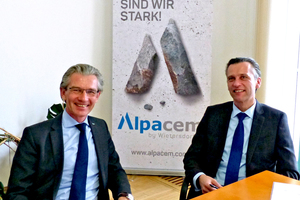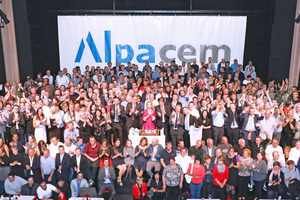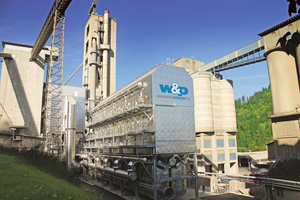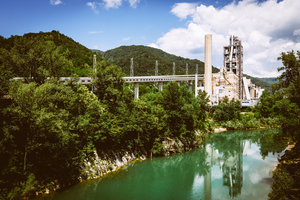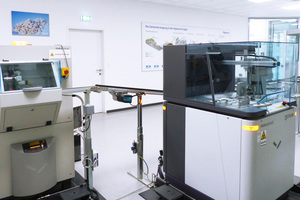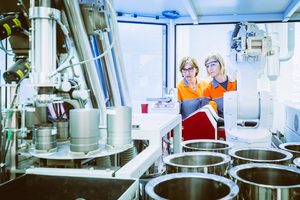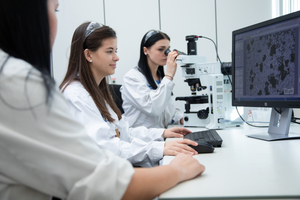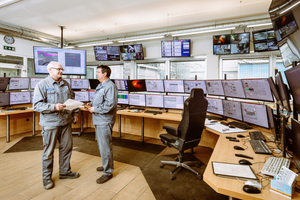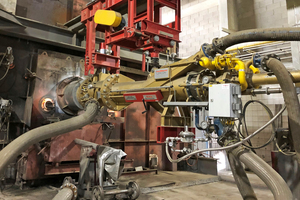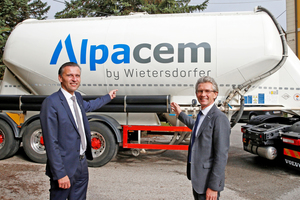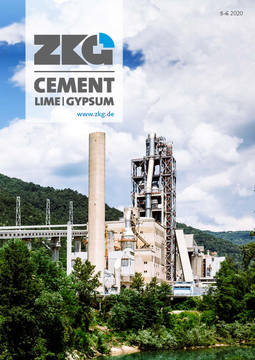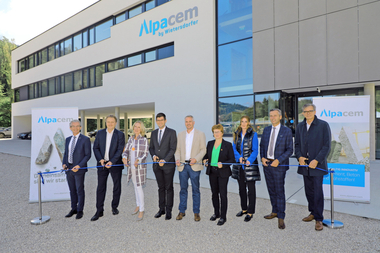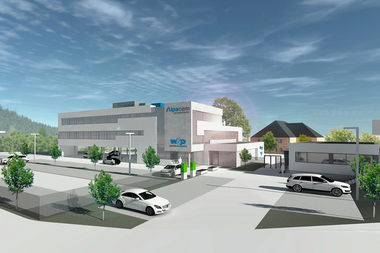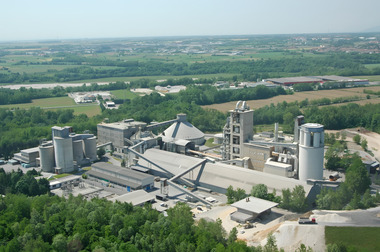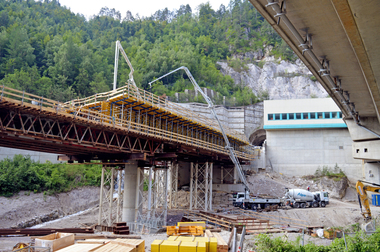From people to people for generations
Since autumn 2018, the Wietersdorfer Group’s Cement & Concrete business division with its 20 locations has been operating under the umbrella brand Alpacem. Dipl.-Ing. Lutz Weber (Managing Director Technology, Personnel and Purchasing) and Ing. Bernhard Auer (Managing Director Sales, Marketing and Business Development) informed us about the development and goals of the new unit.
Weber: Over time, we have found that our strengths become much clearer when we present ourselves under one umbrella brand, which is why we started with the Alpacem brand in 2018. Our aim was to make it clear to our customers and partners as well as our own staff all the things united under the Alpacem name – in the individual countries and in the various business segments. In developing the Alpacem strategy, we therefore focussed on four key areas: costs, compliance, communication and competence.
Auer: In the past we always had “island solutions”. To put it simply, we had one island Slovenia, one island Italy and one island Austria. Our goal with the Alpacem umbrella brand was to bring these units together into one in order to be stronger together. It was important for us that our markets know that we don’t just have two cement locations in Austria, for example, but that Alpacem also owns other cement and concrete plants across the borders to the south and southwest.
We then presented this new umbrella brand to our employees at the 125th anniversary of the Wietersdorf Group.
Has the new brand established itself on the market?
Auer: In the past, our customers were often not even aware of our different plants. For example, if a customer always worked with the Wietersdorf cement plant and now needed a special grade produced by our Slovenian plant Salonit Anhovo, then it was an “outside” supplier for him and not Alpacem. We wanted to change that.
With the umbrella brand, we can now make it clear that Alpacem can source from its different locations, that we have several brands at our disposal, which we can offer in Austria as well as in Italy and Slovenia. For our customers, this not only offers security of supply for normal cements. Alpacem can produce specific cements to meet the customer’s special requests. This also sets us apart from the competition. Although we are a medium-sized company and not a large corporation, we can also supply from various plants and countries. Some customers were not aware of this before.
Weber: We deliberately chose the name Alpacem because it covers the entire Alps-Adriatic region. Alpa stands for the Alps-Adriatic region and Cem for cement and concrete. Particularly with construction sites in the border region of Slovenia, Italy and Austria, customers can see that Alpacem has locations in these countries and can thus assure delivery guarantees.
Auer: In addition to the external effect, the internal effect was also very strongly felt. In the past, this increased cross-border cooperation did not exist, so that many of our employees did not even know of our individual locations in the different countries.
Auer: Alpacem produces around 2 million t of cement and binding agents and over 300000 m³ of concrete at 20 sites per year. In recent years we have recorded steady growth. Last year Alpacem achieved a total turnover of more than € 180 million.
As it is our goal to continue growing and to expand our market position in the Alps-Adriatic region, we have also invested in the market itself. Alpacem has acquired holdings in the concrete sector and we have entered the gravel sector as a means of securing raw materials. In Italy, we acquired the “Terminal/bagging” operating branch of the Trieste cement plant from Italcementi in 2019, in order to expand further south, i.e. Croatia, Bosnia, in addition to our core market.
Weber: A key criterion is our total of 660 em-ployees. There is a lot of know-how and, above all, different knowledge in each individual employee, because every country has developed differently. We want to make the best possible use of these strengths. That is why we have introduced so-called “cross-country” functions. On the one hand, we are small and fast, but on the other hand, we don’t have the kind of personnel base that a large corporation has. We can’t employ several people for R&D. That’s why we have named one person or a small team at all our sites. In this function, these employees are not only responsible for a specific area at their location, but also share their knowledge across countries. This starts with production and covers other areas, right through to health and safety. In this way we want to make the best possible use of synergies and transfer the strengths of the individual units to others. Ultimately, our customers should benefit from this, too. In the area of products, too, this will enable us to make much better use of our experience across national boundaries. Each country has different types of cement, not only for special products, but also for mass cements, which are country-specific. We can still learn a lot from each other here.
Weber: We are focussing on the five strategic areas of innovation, growth, people, unity and excellence! Especially when it comes to innovation and excellence, digitalization is an important topic for us. The installation of a new fully automated laboratory (“Polab”), an investment of € 4 million, in our two cement plants in Slovenia and Austria is a step towards the modernization and automation of the plants and thus a basis for digitalization. The laboratory in Anhovo was commissioned in 2018 and the one in Wietersdorf in 2019.
We are constantly working on the further development of our plants, including the implementation of new process control, data management, process information and mill control systems. The latter has already been successfully installed in Wietersdorf and Anhovo, and we are now transferring the concept to our grinding plants; Italy will start using it in 2020. A further investment is a new maintenance management system, which enables us to plan visually across locations. It was installed with the aim of optimizing costs. We started with it in Austria in 2019 and are now extending it to the other locations.
Two of our latest projects include a uniform ERP system for all locations (Cement & Concrete) and a BLS logistics control system.
Auer: We now want to expand this logistics control system further into a distribution control system. Our aim here is to optimize the service and idle times of the trucks. We shall start with the Wietersdorf plant, and if it runs successfully, we shall roll it out to the other locations, not only in the cement sector but also for concrete. In doing so, it is not only a question of optimizing the freight itself, but also the service for our customers. This gives them the opportunity to place their trucks exactly where they want them to be, and they do not have to put up with unnecessary waiting times, so they can make better use of their fleet.
On the basis of the new ERP system, we will optimize construction site logistics with the aim of ensuring that the right product is at the right construction site at the right time.
The cement plant in Wietersdorf has been a pioneer in environmental protection for around five years now. Please summarize the innovations briefly.
Weber: It has always been one of Alpacem’s strengths that the development of the plants in the group is permanently advanced. Our owners attach great importance to ensuring that our production facilities are state of the art. In both cement plants, Wietersdorf and Anhovo, we have invested in the latest technology, including a five-stage preheater with calciner, a bypass and a push grate cooler. With the latest burner technologies, the RTO afterburning system and other emission reduction measures, our plant in Wietersdorf has set standards in the industry. A showcase project is the X-Mercury plant, a joint development in partnership with the plant engineering companies Scheuch and A TEC to reduce mercury emissions. All these investments contribute to a significant reduction in emissions. This contribution to more climate protection and air pollution control is very important to our Group. We therefore make sure that we also develop the other plants with the knowledge gained from these projects.
What new projects are you focussing on?
Weber: The reduction of CO2 emissions, the production of low-CO2 binders and the development of CO2-neutral concretes are our focus. We cooperate with universities, for example in Austria with those in Leoben and Graz, as well as with universities of applied sciences here in Carinthia. In Slovenia, we work together with the Jožef Stefan Institute in Ljubljana, one of the largest research institutes in Slovenia, and with the University of Ljubljana. In addition to environmental issues, such as the further development of the X-Mercury and the RTO, product development is another important aspect of our project work. All developments and optimizations have been driven forward by our own teams in the plants, in addition to our daily business. It is important for us to exchange information regularly so that everyone is informed about what is happening in the individual plants. In this way, we prevent different plants from starting the same project. One guarantee for our success is that a project is always carried out in one plant. If it is successful, it is transferred to the other plants. This applies to product development as well as to technological optimization. In this way, we make better use of our resources, increase efficiency and at the same time promote cooperation. In addition, the employees look beyond their own horizons. Our aim is to operate as a single unit with Alpacem. For us, excellence means getting the best from each of our locations.
Auer: We are a family-owned company and the direct line to the owners, who want to continuously advance our company, is our great strength. For us, further development means learning from others. For example, management learned about agile management and cooperation with start-ups on a trip through Silicon Valley. We are currently focussing on how to structure goal-oriented cooperation with start-ups.
Another important point is our public image, to show that we offer high-quality jobs. We want to show that cement plants are not just grey. That is why we are planning a new office building and a new traffic management system for the Wietersdorf location. This project will extend over the next three or four years and is intended to make the Wietersdorf location fit for the future and thus more modern in its external presentation.
The cement industry is an energy-intensive industry. What possibilities are you pursuing to save fossil fuels and reduce CO2 emissions?
Weber: In the last five years, we have realized a great deal of investment in climate protection. In Wietersdorf, this includes the installation of the X-Mercury system to reduce mercury emissions, the RTO afterburning system and new burner technologies. In Slovenia, we commissioned an odour reduction plant for alternative fuels in 2018, not only setting new standards but also creating better working conditions for our employees. In one of our latest projects at the Salonit Anhovo plant, a new crusher from thyssenkrupp just started operation at the quarry at the end of February. This investment will allow us to operate the raw mills with optimized energy efficiency and ultimately reduce CO2 emissions.
Our Group has been very active in the use of alternative fuels for a long time. In this respect, we have planned two major measures to further increase the proportion of alternative fuels and thus reduce CO2 emissions. Our current average is about 70 to 80 % addition of alternative fuels – we want to reach 100 %! The time frame in which we achieve this depends on the granting of relevant permits. We are currently planning a gradual increase in the proportion of alternative fuels, as we also want to assure the quality of our products
Auer: As a medium-sized company, we do not have sufficient capacity to conduct basic R&D research on topics such as carbon capture. Therefore, we are focussing on reducing CO2 emissions by using alternative fuels and recycling materials. In cooperation with universities and start-ups, we are working on research projects on CAS cements, low-CO2 cements and concretes. Over the last five years, the Alpacem Group has invested an average of € 20 million per year in growth and new technologies at all locations. This is a considerable sum for a medium-sized company with an annual turnover of € 180 million.
Weber: For Austria, the modernization of our hydropower plants is an important contribution to the use of green energy. Here at the Wietersdorf site we have several hydropower plants dating from the 1920/30s. These are now being completely modernized with an investment of € 10 million by 2021. The plan is that the power plants will supply 25 % of the Wietersdorf site with green electricity after conversion.
How are you, as an employer, combatting the shortage of skilled workers and how do you regulate the succession of employees in key positions?
Weber: We have reorganized our apprentice training activities and entered into a partnership with a local energy supplier. This has enabled us to professionalize apprenticeship training. In this new project, our apprentices receive a multifaceted basic training with a focus on industry 4.0 competences. Overall, Alpacem is heavily committed to training, be it in the design of new brochures for recruiting young people or participation at apprentice fairs. Our apprentices are involved both in day-to-day business and in various special projects – such as the modernization of the hydroelectric power plants around the Wietersdorf site – and thus receive in-depth practical knowledge.
We are investing heavily in our personnel and strengthening our team at an early stage with candidates who want to develop and take on respon-sibility. Therefore, I can say for our company that we have no shortage of skilled workers.
Auer: In Italy, we have managed to strengthen our teams effectively and now have a large number of employees aged between 22 and 28, although the recruitment of skilled workers is different from that in Austria on account of the different training system. Here you go to technical colleges and recruit graduates for your company early on.
Here in Austria, we attach great importance to creating local proximity and recruiting employees who are based here. This is good for the region and for us. In Slovenia, we are facing a generational change in the next three to five years and are looking for new employees. This is an exciting challenge, as we are not the only ones active in Slovenia. In order to meet this strong competition, we are working on making our location fit for the future with topics such as digitalization, modernization, sustainability and thereby offering high-quality jobs.
Weber: We are also committed to the “great place to work” project. This involves conducting an employee satisfaction survey every three years. On the basis of the results, we are trying to further optimize and create attractive jobs for our employees. Our goal is to instil a “we” feeling in our employees at the individual locations. In order to achieve this, we organize transnational company events, where mixed teams with employees from Italy, Slovenia and Austria work together.
For us, it is essential to have our employees behind us, because without people, nothing works.
Auer: That’s right, we want to shape our operations with our employees and respond to their wishes and suggestions for improvement. This includes activities such as the activation of a works canteen and the “Away from plastic” campaign. Here we removed the plastic cups from all coffee machines and gave each employee a thermos flask as a gift. This is not only encouraging employee loyalty, but sustainability in action.
Why are there so few women in the cement industry?
Weber: At Alpacem we have a number of female managers, including in HR and IT, and in the management of the concrete division. This extends through all departments and levels, right up to production. We hope that even more women will apply to us, especially for an apprenticeship. Getting more female apprentices would be great and would certainly have a very positive effect. I am convinced that cooperation is simply better with a mixed team. Women are an absolute asset to our industry.
Auer: I think you have to sell a job in the cement industry in such an attractive way that female employees apply to us. It doesn’t depend so much on what professions we have to offer. We simply have to draw attention to our positives and, as a management team, set an example that woman power is wanted in our company.
You are both cement and ready-mix concrete producers. What activities are you undertaking in the concrete business to become more climate-friendly?
Auer: For us, it is important to know where our concrete products are used, because that way we can better optimize our product cement, which is an intermediate product. If we constantly develop our concrete operations, have a local presence and know exactly what requirements the construction companies have, then we can help shape projects. Concrete and cement are linked to each other. There is also great potential for further development in the concrete sector, particularly with regard to low-CO2 concretes. The use of recycled materials in concrete is a very important issue here. Our aim is to use even more recycled materials, and this will require new types of cement. Approvals and authorizations play an important role here again, it’s a long process. The use of more recycled material requires new standards in some cases, and it will take years before these are implemented throughout Europe. The trend is therefore back towards national standards, so that implementation is easier and quicker.
Weber: Our task as management is to transparently communicate and involve the public in decisions such as increasing the proportion of substitute fuels and substitute raw materials.
Are you involved in 3D printing in concrete? Does it have the potential to prevail over conventional construction methods?
Auer: There is of course potential for 3D printing, which has not yet arrived on the market. For architecturally challenging projects, there are already good ideas where 3D printing will certainly have applications. We see potential above all in prefabricated elements. This will require special cements and binders and special concrete formulations.
3D printing, BIM and prefabrication go hand in hand if you want to build well simply and quickly and without skilled workers. This is very interesting for us because we look at the entire chain, from cement to concrete, and we strive to cover all areas at all times, from cement to the end-customer.
Weber: BIM and prefabrication will be an important aspect in the future with regard to further CO2 reduction. Our goal is to optimize all processes and avoid the generation of CO2 in the process.
//www.alpacem.com" target="_blank" >www.alpacem.com:www.alpacem.com

